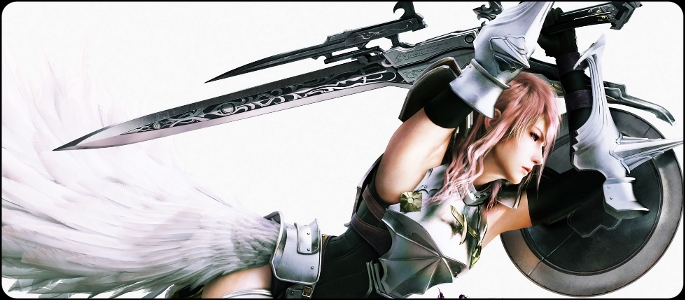[Editor’s Note: Review is of Japanese version of Final Fantasy XIII-2, purchased at the expense of the reviewer. The reviewer lives in Japan and speaks/reads Japanese.]
A story that spends 20 hours causing headaches before turning its ship around, a soundtrack with a severe identity crisis, a jumping mechanic that can’t figure out how it wants to work, monster allies, maps that are no longer shoe strings, beautiful environments with opportunities to explore, an addictive level-up and customization system, time travel, and a heavy metal red Chocobo whose theme lyrics will literally ask you “Are we in Hell?” This is Final Fantasy XIII-2.
Final Fantasy games have been highly divisive this last decade, and XIII was even more polarizing than usual. So you know your reviewer here, I thought Final Fantasy XIII had some good stuff going on, but ending up being an overall average affair. It had great things, it had some disappointments, but I found it to be worth playing, though it’s perfectly understandable why a lot of people didn’t. What’s sad is that Final Fantasy XIII-2 feels like over compensation, as if the developers tried to include way too much, the result of which forms a game largely without an identity of its own. There’s a lot of good in this game, but so much of it is smeared with other aspects that disappoint or underachieve.
Final Fantasy XIII-2‘s music is a big example of its identity crisis, with types of music that feel mismatched and don’t fit together to make a functional soundtrack. There’s props to be earned by visiting several musical styles within a game’s OST, but the selections rarely feel appropriate. Things get especially awkward when vocal pop-type tracks serve as the BGM for some towns and dungeons. From an orchestrated opening, to some remixes of the XIII soundtrack, right into some J-pop. While running around, looping vocalized songs provide thought-provoking lyrics such as “everything looks shiny.” That’s deep. Later in the game, the music does improve, thanks mostly to having these painfully bad vocal tracks show up less frequently. Some of it is actually some real, solid RPG music that makes one wonder where the heck this stuff was from the get go.

The same thing happens with the story. For about 20 hours, the convoluted plot and poor writing render this story almost unbearable, but then there are these glimmers of hope, these shining moments when one must — as with the music — ask all too late “Where have you been this whole time?” By the end, however, most of that even washes away as complete nonsense and over-the-top direction come back from lunch break.
This tale isn’t helped at all by the two main characters. Sora’s older brother in both stance and pants, Noel is sent by Lightning to protect Serah, and he immediately starts trying to stuff his huge ego into everything. He’s a boring character that is hard to care about. From his introductory moments until the end, he’s ripped right from any of a hundred manga franchises. His dialogue is predictable, and he spends all game being a prototypical anime jackass. Simply having bad things happen to you does not make you a good character. Even when the rest of the cast members are evolving, he isn’t, and it eventually leads to eye rolling and makes it hard to care about him late in the game. All of his lines are the same type spewed by characters like Snow (FFXIII), Naruto (Naruto), Avan (Valkyria Chronicles 2), and the other “I’m gonna be the hero!” toolshacks of anime and games. JRPGs and anime have provided some great characters, but Noel isn’t one of them. He could be used in a writing class as an example of a poorly made character.
Serah is a little better. At least, during the middle of the game, she comes around, she grows, we see some of what is called in the business, “character development.” It’s just tragic that it takes so bloody long. For the first half of this 40-hour game (excluding epilogue), however, she struggles. If you want the audience to care about making choices as a lead, you have to make us enjoy being in her shoes. Making most of Serah’s dialogue options brain-dead bimbo things like “I don’t understand what you’re saying!”, especially when what’s going on is perfectly understandable is a terrible decision. Even if the player doesn’t pick it, the fact that it was even a possibility suggests that it’s a thought that was floating around in Serah’s head. Worse, there are several conversation selections that specifically don’t include an intelligent response. Sorry, I don’t want to play as a character who repeatedly demonstrates her idiocy. Serah is constantly asking questions with the perfect inflection and tone which lets you know that behind that mouth of hers is a whole head full of air. Naturally, Noel is constantly mansplaining things with his infinite wisdom.
The tremendous value of subtlety is lost on writer/director Motomu Toriyama. Rather than allowing the player to see things unfold and understand them, the player is smacked over the head with unnecessary filler dialogue. Get ready to have your intelligence repeatedly insulted, sometimes directly, sometimes using Serah’s airheadedness as the vehicle. Things the player obviously understands will then be explained and re-explained, often through Serah asking stupid questions. And when the answer isn’t so obvious, or there appears to be a contradiction, Toriyama shrugs and goes “Um, whoops, uh, time paradox!” and calls it good. Proving that the claim of developers fixing all the problems with XIII was exaggerated, there are, once again, large story chunks that need to be read in plain text form. This might be the worst story in Final Fantasy history.
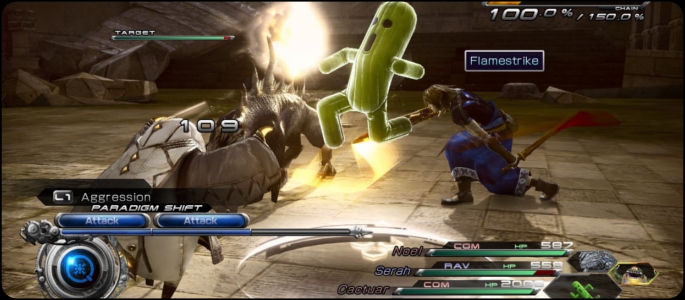
Mog is perhaps the best example of squandered opportunity and destruction of subtlety. What could have been a funny, cute, enjoyable side character is made into an overused one-note joke that inappropriately injects itself into nearly every conversation. Scaled back a little bit, and Mog’s comic relief could have been a great addition to the cast, but eventually his voice and antics get annoying because of just how overused they are. Most of Mog’s sound effects and shorter voice clips are recycled from Final Fantasy Type-0, which hasn’t come out in North America, so perhaps Square Enix is banking on you not noticing, but I did notice because fuck.
A jumping mechanic further demonstrates Final Fantasy XIII-2‘s multiple personalities. Players can tap O to jump at will, and on rare occasion, this will prove useful in exploration, but it’s fairly inconsistent. Sometimes she can leap right over a fence waist-high, but others, invisible walls hold her back from hopping something only up to her ankles. It’s random and sloppy. At other points, there are glowing circles in which Serah’s jump will launch her into a sort of automated sequence similar to what was done in XIII. Auto-jumping can work fine, manual jumping can work fine, but Final Fantasy XIII-2 uses a mish-mash of the two for no particular reason. For most of the game, there’s not much point to the manual jump, until the platform-loaded final dungeon. Why was there no other platforming before this point? If given enough attention, it may have opened up some neat possibilities. But there we are again with the main theme of FFXIII-2: not really focusing on one thing and doing it well, but struggling to include anything and everything that anyone could have ever liked.
Instead of feeling like its own game, Final Fantasy XIII-2 feels like Motomu Toriyama trying to show off to Tetsuya Nomura, as if to prove hey, “I can make a crazy game with no gravity and stuff, too!” We got used to the no-gravity thing in Advent Children, and you have to make allowances for video games — even more for ones that include time travel — but some scenes in FFXIII-2 are off-the-wall ridiculous. There’s so much going on, to the point all these extra backflips and flying and swooping aren’t badass anymore, they feel forced and lame. Just because it’s possible to make a big flashy scene doesn’t mean it makes the game better. Tone it down a notch.
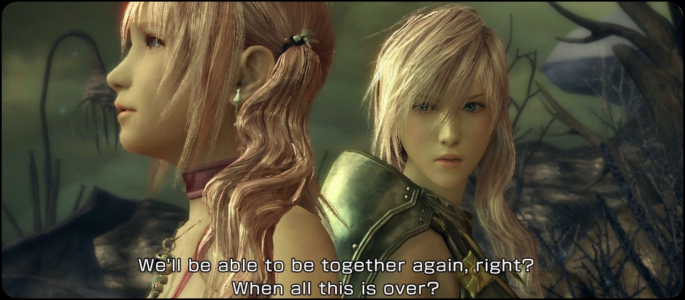
In a lot of ways, this sequel doesn’t run with some of the things Final Fantasy XIII did well, most prominently the tension of the world. Certain story elements that promised good things in XIII are hardly given a passing reference in XIII-2. While there are NPCs to talk to, we very rarely see any real, everyman citizens of the world doing their thing. What’s the social climate of these worlds and time periods we’re visiting? We don’t know.
Not all promises of gameplay amendments were broken, however. Exploration makes a welcome return. Especially after its introductory stages (about 6 hours), Final Fantasy XIII-2 puts players into some big, beautiful areas that are genuinely interesting and fun to explore. One of the big drawbacks to XIII was that its characters were running around these graphically impressive, nicely designed areas that really only had one place to go and gave no reason to look around. Heck, looking around wasn’t even possible in most of the places. This sequel thankfully ditches that, for the most part. It’s not a genre pioneer or anything, but the game does contain lots of areas that feel very rewarding to check out in full. Players who do so will usually be rewarded with items, gate keys, and of course, a few more chances to fight.
Another element of Final Fantasy XIII turned almost completely around in XIII-2 is the linearity. Once time travel possibilities are opened, the player really gets a lot of control over where the team goes and when. Several areas might open up at once, so from the menu, there’s a big decision to make as to where to go. Each place and time period has its own consequences, story bits, and other reasons the group might wanna check it out, making the decision all the more exciting. One can even see several scenarios play out differently depending on decisions made, up to and including different endings, which can be quite good. This was one of the biggest things the first game lacked: the ability for a player to make his adventure at least somewhat unique from that of other players. It feels great to have the aspect back. Saying this is in part a knock against XIII and in part praise for XIII-2; while XIII‘s laughably small amount exploration and over linearity drew complaints, those aspects are completely revived in XIII-2. The utilization of time travel is done particularly well — so much so that it might even draw complaints from Chrono fans that this mechanic wasn’t saved for a third game in that series. The story itself is convoluted and silly, but wow is that time travel pulled off well. There’s some great post-ending content that allows the player to continue zipping all around time and space, finding new areas and making sure to explore the old ones to the fullest, which will not be easy.
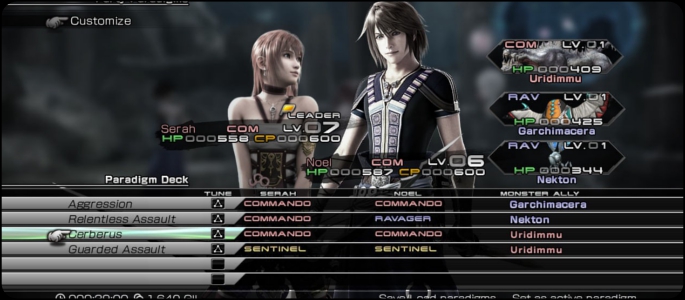
For the most part, battles have remained the same as they were in FFXIII, the biggest change being summons swapped out for group attacks. The same combatant roles are there, and players can once again group them as they please to fit their play style. Changing strategies for certain boss fights is a necessity, and drawing up the battle plans now has an extra twist. The third party member is a captured monster. Any monster that the team captures (this is done automatically, by chance, after winning a battle) can become an ally and has one specific role. Players select three different monsters to have on board for battles and then configure their Paradigms. This is where the game can get really addictive for level-up fiends, as monsters make progress through use of items, the vast majority of which can only be found after battles. Wanna get that next little smidge of statistical progress for your monster buddy? That’ll be two items. Another level will be two more. It’s strangely engaging to be constantly checking on the monster’s stats and wondering if another beast in the group could potentially prove more useful than one of the three in your main group, improving your little dudes a small step every handful of battles. Final Fantasy XIII did have some super cute enemies as well as a few badasses, so having them along for the ride, while probably sounding awful to some people, is surprisingly fun.
That right there is where Final Fantasy XIII-2 does truly shine. The gears of a great RPG are really there. It’s got a good progress system, Square Enix managed to create a leveling scheme in conjunction with a combat system that feels satisfying to play and to work through, and it’s easy to be excited about getting those new bits of loot to upgrade your favorite monster. Couple that with the gorgeous environments the party gets to explore and the framework is there for something great.
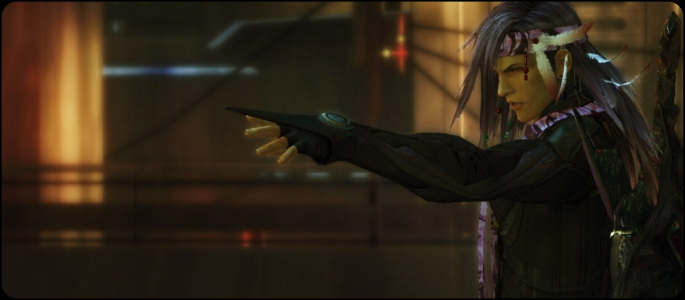
Making multiple saves per playthrough is odd in Final Fantasy XIII-2, as it can only be done in the Historia Crux menu, not in the field or town. Saving while exploring simply prompts an autosave that overwrites the previous file. If you’re wanting to compare the effectiveness of a certain character in a certain role or see if spending your monster items on Cait Sith is actually worth your time, you’re stuck with the inconvenience of having to exit the area, save, then re-enter the area of your choice, which can seem a little bit jerky and interfere with the flow of the otherwise fast battling and leveling. The Historia Crux causes an autosave of its own, and other autosaves happen before most story sequences. How many of us have multiple save files of our favorite JRPG, that were created along a singular play? People like to do that, so it being this oddly planned by including so much loading feels strange. (Update: This system is available for creating new saves in the Japanese version of the game, but at this time, stateside reviewers with pre-release copies are claiming that there is no way to create multiple save files. NA version comments cannot yet be confirmed, though the criticism of the Japanese version remains.)
Those who despised Final Fantasy XIII have no reason to even attempt the sequel; those that did should take it as highly recommended. If you play RPGs with your focus on plot, characters, and storytelling, you’re probably best to drop this game off your radar, unless you’re cool with it taking 20 hours to get good. If you play it for interesting progress systems and combat, it becomes interesting close to the five-hour mark and for the most part, holds its own. It’s a hard game to review, because you’re gonna get sacks of hatemail no matter what. Praise this game and you’re “contributing to the downfall of the series,” slam it and “you just didn’t get it, man.” Millions of people will fall very passionately on both sides of this one. For me, Final Fantasy XIII-2 lands right smack in the middle.
PlayStation LifeStyle’s Final Score
– Perhaps the worst story in Final Fantasy history. |
 |
_
